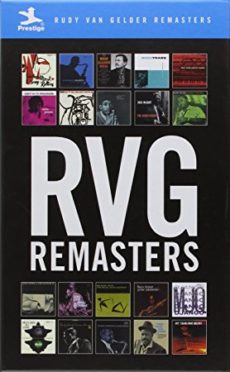
Daily Dose Of Jazz…
Rudolph “Rudy” Van Gelder was born on November 2, 1924 in Jersey City, New Jersey. His interest in microphones and electronics can be traced to a youthful enthusiasm for amateur radio. Named for his uncle who had been the drummer in Ted Lewis’s band in the mid-1930s, he took trumpet lessons and trained as an optometrist at the Pennsylvania College of Optometry, in Philadelphia, thinking he could not earn a living as a recording engineer.
From 1943, after graduating, Van Gelder had an optometry practice in Teaneck, New Jersey, and moonlighted recording local musicians in the evenings who wanted 78-rpm recordings of their work. From 1946, Van Gelder recorded in his parents’ house in Hackensack, New Jersey, in which a control room was built adjacent to the living room, which served as the musicians’ performing area. The dry acoustics of this working space were partly responsible for Van Gelder’s inimitable recording aesthetic.
Interested in improving the quality of the playback equipment he acquired everything that could play back audio: speakers, turntables and amplifiers. One of Rudy’s friends, baritone saxophonist Gil Mellé, introduced him to Alfred Lion, a producer for Blue Note Records, in 1953. Within a few years he was in demand by many other independent labels based around New York City, such as Bob Weinstock, owner of Prestige Records. To accommodate each label – Blue Note, Prestige, Savoy, Impulse, Verve he assigned them to different days as Lion was more stringent with the sound of original music, Weinstock had essentially blowing sessions for some of the best musicians in jazz history.He also engineered and mastered for the classical label Vox Records in the Fifties.
Van Gelder worked during the day as an optometrist until the summer of 1959, when he moved his operations to a larger studio in Englewood Cliffs, New Jersey and became a full-time recording engineer. The new studio’s design was inspired by the work of Frank Lloyd Wright had high ceilings and fine acoustics with “no food or drink and do not touch microphones” policy as he himself always wore gloves when handling equipment.
By 1967 the labels were beginning to utilize other engineers more regularly but Rudy remained active engineering nearly all of Creed Taylor’s CTI Records releases, a series of proto-smooth jazz albums that were financially successful, but not always well received by critics. He was not without his detractors. Despite his prominence in the industry, like Lion who didn’t care for the overuse of reverb, and Charles Mingus refused to work with him because he change the sound of his bass. He remastered the analog Blue Note recordings into 24-bit digital recordings in its RVG Edition series and also remasters of some of the Prestige albums, and was happy to see the LP go by the wayside because it was hard for him to get the sound the way he thought it should be.
He received awards and honors being named a fellow of the Audio Engineering Society (AES), received the society’s most prestigious award, the AES Gold Medal, named a Jazz Master by the National Endowment for the Arts, received the Grammy Trustees Award, and Thelonious Monk composed and recorded a tribute to Van Gelder titled Hackensack.
Producer and recording engineer Rudy Van Gelder, who specialized in jazz and regarded as the most important recording engineer of jazz by some observers, passed away at home in Englewood Cliffs, New Jersey on August 25, 2016. Among the several thousand jazz sessions he recorded are the acknowledged classics John Coltrane’s A Love Supreme, Miles Davis’s Walkin’, Herbie Hancock’s Maiden Voyage, Sonny Rollins’s Saxophone Colossus and Horace Silver’s Song for My Father.
![]()


